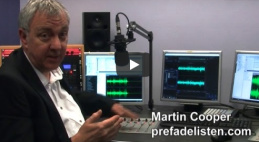…Or is it just noise? This website is called ‘pre-fade listen’. That’s a bit of radio jargon that I’ve tried to explain elsewhere.
 For example, I’ve recorded a video where I point to a pre-fade listen button on a studio mixing desk and talk about how it allows the on-air presenter to make sure that his or her next audio item will play out at exactly the right sound level.
For example, I’ve recorded a video where I point to a pre-fade listen button on a studio mixing desk and talk about how it allows the on-air presenter to make sure that his or her next audio item will play out at exactly the right sound level.

So, here’s a picture of the CD of the 1995 track from Björk. It’s the one track that makes you sit up and pay attention to your PPMs (peak programme meters) on your studio desk. This was the piece of pop music that really frustrated me in those years.
And by way of comparison here’s the music video from that year, directed by Spike Jonze. It’s interesting how the video-sharing platform has compressed and limited the audio to such an extent that you don’t get the power of the dynamic range of Björk’s superb performance.
So, why are audio levels important in radio broadcasting? Too loud and the audience will complain; too quiet and the listener will be fiddling with the volume knob – and in all certainty quickly re-tune to a decent station that plays music and speech which sits nicely in the background audio landscape of their lives.
In the on-air studio, good radio broadcasting is all about looking to the next audio event in a live show – and being prepared to play it out at just the right level. For the listener it’s about having a steady professional sound coming out of the radio.
On a BBC Local Radio mixing desk, the speech always peaks at six and the music at five on the PPM. I’ve explained about that elsewhere in some detail, with technical drawings and archive pictures.
But that blog-post drew a response from a former BBC staffer who pointed out that Local Radio was just one part of the big BBC audio-technical universe. Chris – who has had experience working on OBs (outside broadcasts) both in the UK and abroad – writes,
You’ll need to be asking a lot of SM (studio manager), engineer and producer types about how things are done on different networks, as it’s very different to Local Radio (LR), or else you’ll have generations of them spinning in their graves! Your comment about speech always peaking to 6 and music to 5 for instance.
This may be true on LR and perhaps in the past on the likes of R2, but never on Radio 3, or on Radio 4, and not R1 anymore either. For instance, on an orchestral broadcast on R3 speech would normally peak between 3 and 4, and only be allowed above 4 when over applause. Music would peak between 1 and 6, (or even to 7 these days) to allow it to breath, and better express the dynamic range of an orchestral piece.
The same is true in drama, where dynamic range is used to create atmosphere and effect. What something peaks to is not as important as to how “balanced” (volume wise) a programme sounds.
On the old Langham SM training course, you had to make programmes having only taken level on the presenter’s voice, the PPM would be covered up, and you had to do the rest by ear.
It was great training, and made you listen to how loud something was in relation to the overall balance. The new “loudness” meters appearing in BBC studios now do something very similar. I could bang on about technical stuff all day, but enough for now!
All the best,
Chris
Which I gratefully receive. Indeed, I’m keen to include all points of view on radio matters. I am guided in this by a former editor of mine, one Ian Mayes. Before joining the Guardian newspaper, he worked for BBC Radio News and had a short spell (known in the corporation’s jargon as ‘an attachment’) as news editor at BBC Radio Derby.

He was the journalist who drummed in to me the need to use apostrophes correctly, and to check my work for punctuation and spelling (any mistakes on this page are, therefore, mine alone…). Ian went on to become the editor of the Guardian’s Open Door column. A number of his articles about the art of journalism have previously been published in book form.
And one final thought: “Loudness is subjective.” That’s according to Ian Astbury (of BBC Technology). Read his full article to discover the context of his statement. Let me know what you think.
Thanks Martin, this is fascinating and will bear in mind the points in my own productions. I also love all your links and look forward to follow some up. And I love that Bjork song!
LikeLiked by 1 person